The Ultimate Guide to Shopping Online Safely
Understanding the Basics of Online Shopping
Online shopping has revolutionized the way we purchase goods and services, providing convenience and variety at our fingertips. However, with this convenience comes the need for increased vigilance to ensure a safe shopping experience. Understanding the basics is crucial to protecting your personal and financial information.

Choose Reputable Websites
When shopping online, always start by selecting reputable websites. Look for well-known retailers or those with positive reviews from previous customers. Check for contact information and customer service options to ensure the site is legitimate. A good rule of thumb is to avoid deals that seem too good to be true.
Secure Your Personal Information
Your personal information is valuable, and it’s essential to keep it secure. Only provide necessary information during checkout and ensure the website uses encryption. Look for a padlock symbol in the browser's address bar, indicating a secure connection. Additionally, avoid saving payment information on websites when possible.
Safe Payment Methods
Using secure payment methods can significantly reduce the risk of fraud. Credit cards often offer better protection against unauthorized purchases compared to debit cards. Consider using payment services like PayPal, which adds an extra layer of security by keeping your financial details private.

Be Wary of Phishing Scams
Phishing scams are a common threat in online shopping. These fraudulent attempts often come via email or fake websites that mimic legitimate businesses. Always verify the sender’s email address and double-check URLs before clicking on any links. If something seems off, navigate to the website directly through your browser instead of using links.
Monitor Your Accounts Regularly
Regularly monitoring your bank and credit card statements can help you quickly identify any unauthorized transactions. Set up alerts for your accounts to receive notifications of any purchases. This proactive approach allows you to address potential issues before they escalate.
Use Strong Passwords
A strong password is your first line of defense against cyber threats. Use a combination of upper and lowercase letters, numbers, and symbols to create a unique password for each account. Consider using a password manager to keep track of your credentials securely.

Utilize Two-Factor Authentication
Two-factor authentication (2FA) adds an additional layer of security by requiring a second form of verification beyond your password. This could be a code sent to your phone or an authentication app. Enabling 2FA on your accounts significantly reduces the risk of unauthorized access.
Keep Your Devices Updated
Ensuring your devices have the latest security updates is vital in protecting against malware and other online threats. Regularly update your operating system, browser, and antivirus software to safeguard your online shopping activities.
Conclusion
Shopping online safely involves a mix of vigilance, knowledge, and proactive measures. By choosing reputable websites, securing your personal information, using safe payment methods, and staying informed about potential threats, you can enjoy the benefits of online shopping without compromising your security.
